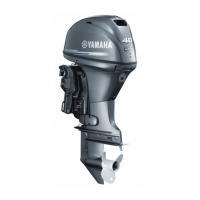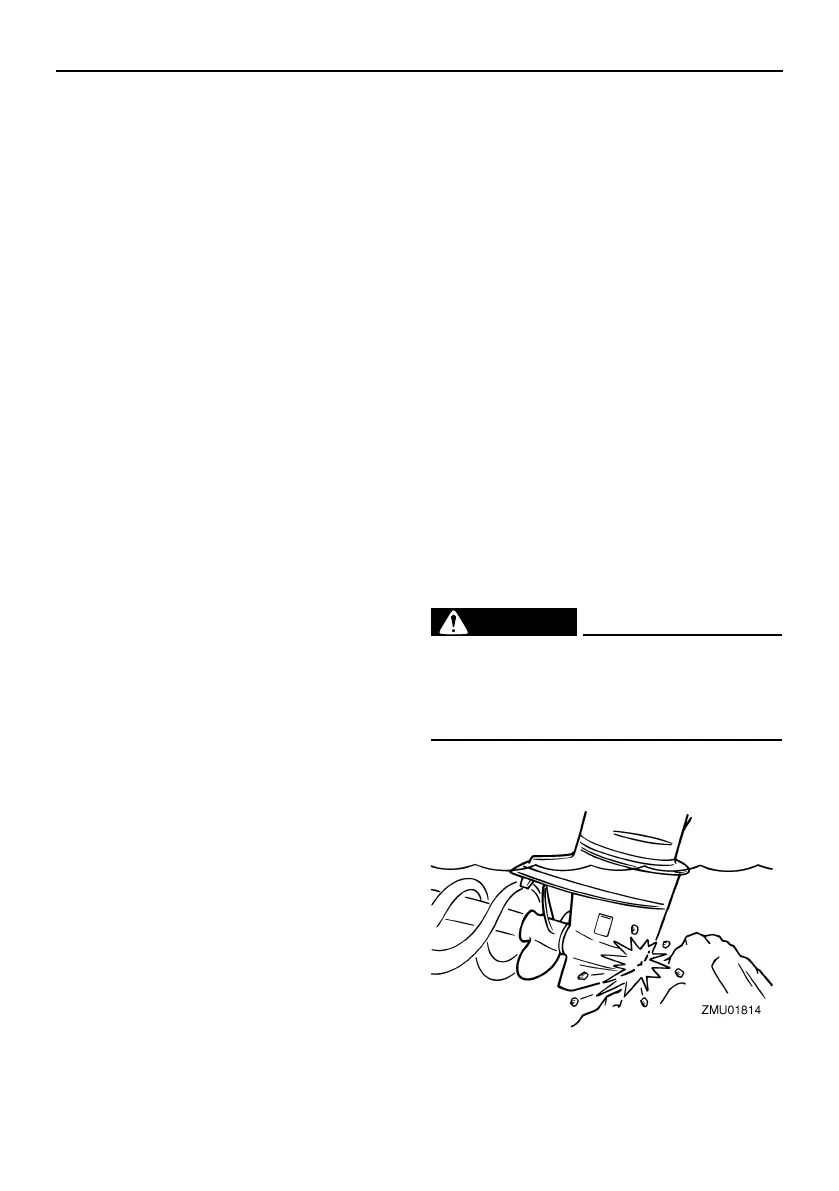
 Loading...
Loading...
Do you have a question about the Yamaha F40F and is the answer not in the manual?
| Engine Type | 4-Stroke |
|---|---|
| Displacement | 747 cc |
| Maximum Output | 40 hp |
| Cylinder Configuration | Inline 3 |
| Fuel Induction System | EFI (Electronic Fuel Injection) |
| Starting System | Electric |
| Alternator Output | 16 Amp |
| Steering | Remote |
| Gear Shift | F-N-R |
| Full Throttle RPM Range | 5000 - 6000 rpm |
| Cooling System | Water-cooled |
| Bore x Stroke | 65 x 75 mm |
| Shaft Length | 20 in |
| Fuel Tank Capacity | External |
Introduces the manual's purpose and provides contact information for support.
Explains the meaning of important symbols like WARNING, NOTICE, and TIP used in the manual.
Covers hazards like propeller, rotating parts, hot components, electric shock, and trim/tilt.
Details the risks associated with gasoline, including flammability, spills, and vapors.
Provides essential safety advice on alcohol, PFDs, awareness of people in water, passengers, and overloading.
Offers guidance on preventing collisions, checking weather, and adhering to regulations.
Instructions for recording serial and key numbers for future reference.
Information regarding EC Declaration of Conformity (DoC) and CE Marking for the outboard motor.
Emphasizes the importance of reading all manuals and labels for safe operation and maintenance.
Provides detailed explanations for various warning labels found on the outboard motor.
Explains the meaning of various symbols used throughout the manual for clarity.
Details on power unit type, displacement, bore/stroke, ignition, steering, and starting systems.
Specifies operating ranges, rated power output, and idle speed for the outboard motor.
Lists physical dimensions, weights, recommended fuel type, and engine oil specifications.
Key requirements for safely installing the outboard motor, including horsepower limits.
Specifies requirements for remote control systems and proper battery installation and type.
Guidance on choosing a propeller and detailed engine oil specifications.
Information on gasoline, gasohol, and precautions for operating in muddy or acidic water.
Advice on anti-fouling paint, motor disposal, and essential emergency equipment.
Visual guide to identify all major parts of the outboard motor.
Details on the fuel tank, fuel joint, fuel cap, and air vent screw functions.
Explains fuel gauge operation and the functions of the remote control transmitter.
Information on the Yamaha Security System, remote box, and control lever operation.
Details on neutral interlock, throttle lever, tiller, and gear shift operations.
Guidance on using the throttle grip, indicator, and friction adjuster.
Explains the operation of the engine shut-off cord and stop button for safety.
Instructions on operating the main switch and adjusting steering friction.
How to use the power trim and tilt switches located on the remote and cowling.
Adjusting trolling speed with switches and tuning the trim tab for optimal performance.
Details on tilt lock, support knob, and the cowling lock lever for motor access.
Explains the fuel filter/water separator function and the alert indicator system.
Details on the low oil pressure and overheat alert indicators and their meanings.
Explains the display and functions of the digital tachometer.
Details on tachometer, trim meter, and hour meter displays and their uses.
Explains the operation of the digital speedometer and fuel gauge.
Describes display modes for trip meter, clock, and voltmeter functions.
Covers fuel level, battery voltage alerts, and types of multifunction meters available.
Details on the various functions and displays of 6Y8 multifunction meters.
Shows Yamaha Security System status and how to adjust trolling speed.
Provides detailed information on low oil pressure and overheat alert conditions and actions.
Explains alerts for water in fuel and general engine malfunctions, with recommended actions.
Covers battery voltage alerts and detailed functions of speed/fuel meters.
Explains the various functions, display options, and sensors for 6Y8 speedometers.
Details the functions of fuel flow, consumption, economy, and remaining fuel displays.
Introduces the engine's alert system, which warns of potential issues.
Details specific alert conditions for overheating and low oil pressure, and required actions.
Covers proper motor placement, balancing, height, and potential issues like overheating.
Covers initial checks, filling engine oil, and the engine break-in period.
Essential checks to perform before starting the engine to ensure safe operation.
Procedures for checking fuel level, system, and operating various controls.
How to operate the throttle controls and safety features like the engine shut-off cord.
Steps for checking engine oil level and reinstalling the engine cowling.
Checks for trim/tilt, battery condition, and the procedure for filling the fuel tank.
Guidelines for safely starting and running the outboard motor.
Steps for refueling the boat and starting the outboard motor.
Specific starting procedures for electric and prime start engine models.
Starting procedures for outboard motors equipped with electric start and remote controls.
Checks to perform after starting the engine, focusing on cooling water flow.
Procedures for warming up the engine and safely shifting gears.
Detailed instructions on how to shift the outboard motor between gears.
Procedures for safely stopping the boat and shutting down the engine.
Guidance on adjusting the outboard motor's trim angle for optimal performance.
Adjusting trim angle and understanding its impact on boat stability and efficiency.
Explains the consequences of excessive trim up (bow-up) and trim down (bow-down).
Procedures for tilting the outboard motor up and down for various situations.
How to operate in shallow water and tilting procedures for different models.
Maintenance advice for operating in salt, muddy, or acidic water.
Safe practices for transporting and storing the outboard motor.
Detailed steps for preparing the outboard motor for long-term storage.
Instructions for flushing the cooling system and cleaning the motor's exterior.
Overview of scheduled maintenance tasks and their recommended intervals.
Table detailing initial and periodic maintenance checks and their locations.
Table detailing additional periodic maintenance checks and their locations.
Identifies lubrication points and describes the greasing procedure.
Instructions for inspecting, cleaning, and adjusting spark plugs.
Guide on how to check and adjust the engine's idle speed.
Step-by-step instructions for changing the engine oil.
Checking electrical connections and inspecting the propeller for damage.
Detailed procedures for removing and installing the propeller.
Step-by-step instructions for changing the gear oil.
Procedures for cleaning the fuel tank and inspecting sacrificial anodes.
How to check the battery's condition and connections for electric start models.
Safe procedures for connecting and disconnecting the boat battery.
Basic checks and possible remedies for common fuel, compression, and ignition issues.
Troubleshooting steps for the Yamaha Security System and starter motor problems.
Resolving issues related to irregular engine idling, stalling, and power loss.
Troubleshooting engine power loss and excessive vibration.
Diagnosing engine vibration and other common operational problems.
Procedures for emergency situations and replacing blown fuses.
Resolving issues with the power trim/tilt system and water separator alert indicator.
Troubleshooting steps for when the starter motor or engine fails to start.
Manual procedure for starting the engine in emergencies using a starter rope.
Immediate actions required if the outboard motor becomes submerged.